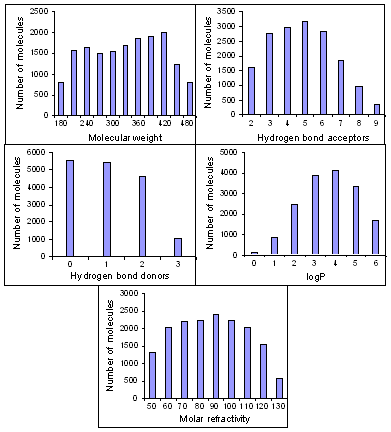 |
|
|
Non Redundant Database of Small Molecules
|
NRDBSM database is aimed specifically at virtual high throughput screening of small molecules and their further optimization into successful lead-like candidates. It has been developed giving special consideration to physicochemical properties and Lipinski's rule of five, which determine the solubility, permeability and transport characteristics across membranes. Some of these are molecular weight, number of hydrogen bond donors and acceptors, log P and molar refractivity. Fixed precincts for these properties have been employed as filters to assemble the database.
NRDBSM database currently holds close to 17000 molecules with simple structures, low molecular weight, less number of rings and rotatable bonds, low hydrophobicity such that after screening, optimization and consequent increase in molecular complexity, they would show a drift towards 'drug-like' property space.
The database is prepared deliberately to avoid biases of normal distribution of these properties. As shown in the distribution plots below, it uniformly spans partition coefficient logP in -1.0 to 6.0 range, molar refractivity from 40 to 130, molecular weight from 150 to 480, number of hydrogen bond donors from 0 to 3 and hydrogen bond acceptors from 2 to 9. The NRDBSM besides facilitating focused searches in larger databases once a hit is identified should also help in finding a small number of hits for further optimization. A Search engine is available for querying NRDBSM based on the properties mentioned. |

Reference:
Shaikh SA, Jain T, Sandhu G, Soni, A, Jayaram B. From drug target to leads-sketching a physicochemical pathway for lead molecule design in Silico. Frontiers in Medicinal Chemistry, 2012, 6, 324-360. Eds: Atta ur Rahman, Allen B. Reitz and M. Iqbal Choudhary, Bentham Publishers.
doi:10.2174/97816080546401120601
|
|
|
|
|
© Copyright 2004-2021, Prof B. Jayaram & Co-workers| Disclaimer |
|

